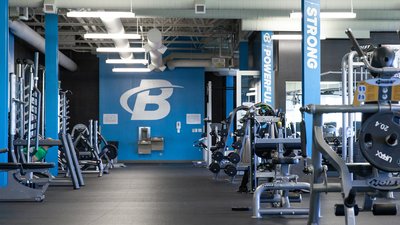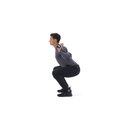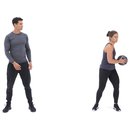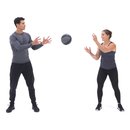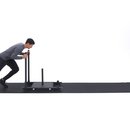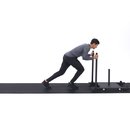Power: A term often used to describe strong, quick movements in athletics. Power is the amount of work done per unit of time. The linebacker buries a running back in the time it takes you to click the remote control. That's pure power, the sum of speed plus strength.
Some power comes naturally, a product of genetics, but you can train for it, too. Techniques like plyometrics, Olympic lifts, and throws are used to train athletes around the world. Powerlifters also use power training to increase overall strength. Although there is no jumping, fast sprints, or agile movements during a powerlifting competition, powerlifters train for power and speed. Their "dynamic" days are training sessions directed toward the speed continuum of power. Speed squats,
speed bench presses, and jumps are all used to increase the speed of the bar and improve the lifter's power output.
If they're not running or jumping, why do they train for power and speed? It all comes back to the force-velocity curve. If lifters have a large amount of strength but no velocity to the lift, their potential output is severely limited. If they're fast but not strong, they're limited by weakness. To maximize muscle recruitment, there has to be a focus not only on maximal strength but also on maximal velocity of the movement.
So what about average gym-goers? General strength exercises and steady cardio form the majority of their program. Is there even a need for increased power production outside of the playing field or the power rack?
Power Up
The answer is yes. Jim the accountant should implement power development into his three-day split because:
1. Power Training Makes You Stronger
The goal of many lifters is to get more muscular, more defined, and just plain sexier. To get your body looking the way you want it to, improve your strength. Just as I mentioned above, speed has to be part of the equation for maximal strength gains. Without power-specific training, there will less neuromuscular control and less muscle recruitment (1). Power training requires faster impulses from the brain to the muscle, creating a higher rate of force development (2). It has also been demonstrated that plyometrics (a form of power training) improve overall strength. In a study by Fatouros et. Al., participants completed weight training and plyometrics, just plyometrics, or just weight training. Each group improved in both strength and vertical jump height, however the group that did weight training and plyometrics showed a higher rate of improvement over the other two groups.
2. Power Training Improves Your Joint Control
Even if you're not planning on competing in a Strongman contest, you'll want to know how to control your movements. If you cannot control the knees or hips while performing a squat, you'll never be able to put much weight on the bar. In a study by Kyrolainin et. Al., subjects performed explosive muscle actions for 15 weeks. At the end of the 15 weeks, rate of force development was substantially improved. More important, there was a change in the joint control strategies of the muscles. With the addition of power movements and improvement in the neuromuscular system, joint control and stability was improved. Better joint stability equates to better lifts and more weight on the bar.
3. Power Training Enhances Longevity
As we age, our balance and other functions can suffer from diminishing nerve connections and reaction time. Normal strength training will help maintain strength and mobility, but it won't do a lot to improve balance and reaction speed. Miszko et. Al., showed that power training an older population had a greater effect on improving its physical function than did strength training; Orr et. Al. showed that power training with high velocities and low loads significantly improved balance over strength training alone. According to these studies, power training can improve daily functioning and longevity.
Implementing Power Training
You have the basics about why you should do power training—now how do you implement it?
In many powerlifting programs, there are separate days dedicated to speed and power development. If you want to use the Westside method, do a primary movement with 40-60% of a one rep max for sets of 2-3 reps; move the load as quickly as possible. Other philosophies say to perform power movements at the beginning of every lifting session. For the general lifter, one or two exercises 1-2 days per week are enough for power development and strength gains. It's also best to do power training early in your training session while your mind and body are fresh.
There are numerous lifts and movements you can do for power training. While Olympic lifts might be best for increasing your power, they're difficult. Without the proper skill or the guidance of an experienced coach, it's probably best to leave them alone. There are numerous movements that could be performed, from Olympic lifting, to jumping, or even sprinting.
These are the power-developing movements I would recommend instead:
Box Jump
The box jump is a simple form of plyometrics. It adds an aspect of speed to the squat movement. The lifter should adopt an athletic stance, descend to a half squat, then explode upward. Box height can be changed to add challenge and progression. Using a box makes landing much less stressful on your knees.
Medicine Ball Slam
Medicine ball slams are a great upper-body exercise. Start with the ball directly overhead. Swing the arms downward to slam the ball into the ground as forcefully as possible. The core is forced to react quickly to stabilize the effort and the shoulders perform movement dynamically.
Kettlebell Swing
Similar to a jump, the kettlebell swing works wonders towards developing the posterior chain. Commonly performed improperly, the swing is not a squat but rather a hip hinge. To get it right, bend at the hips, and then forcefully contract the glutes and hamstrings to thrust the bell forward. On the descent, brace the core, hinge at the hips, and recoil for another explosive contraction.
Medicine Ball Rotational Throw
The rotational throw is perfect for developing power in the transverse plane. Used by many athletes, this throw helps with core stabilization, hip power, and shoulder strength. Stand perpendicular to a wall with an underhand grip on the ball, twist at the hips away from the wall, and then rotate through the hips to throw the ball at the wall as hard as possible. Catch the rebound and repeat.
Prowler Sprint
Load up the prowler and perform short sprints. This not only develops starting speed for sprinters and athletes, but also adds strength to deadlifts and squats. With consistent use of this medieval piece of metal, you might just add a little mass to those bird legs.
Programming
Perform power movements early in the workout following a proper warm-up and complete sets of 2-5 reps. Lower-body power exercises should be performed on lower body days and upper body power movements during upper body training sessions. Try this three-day split:

BodyFit
$6.99/month- 2,500+ expert-created single workouts
- 3,500+ how-to exercise videos
- Detailed workout instruction
- Step-by-step workout tips
- Training at gym or at home
- Access to Workout Plans
- Access to Bodyfit App
- Store Discounts
Already have a Bodybuilding.com account with BodyFit? Sign In

What comes with BodyFit?

- Instructional Videos
Don't risk doing a workout improperly! Avoid injury and keep your form in check with in-depth instructional videos.

- How-to Images
View our enormous library of workout photos and see exactly how each exercise should be done before you give it a shot.

- Step-by-Step Instructions
Quickly read through our step-by-step directions to ensure you're doing each workout correctly the first time, every time.

BodyFit
$6.99/month- 2,500+ expert-created single workouts
- 3,500+ how-to exercise videos
- Detailed workout instruction
- Step-by-step workout tips
- Training at gym or at home
- Access to Workout Plans
- Access to Bodyfit App
- Store Discounts
Already have a Bodybuilding.com account with BodyFit? Sign In

What comes with BodyFit?

- Instructional Videos
Don't risk doing a workout improperly! Avoid injury and keep your form in check with in-depth instructional videos.

- How-to Images
View our enormous library of workout photos and see exactly how each exercise should be done before you give it a shot.

- Step-by-Step Instructions
Quickly read through our step-by-step directions to ensure you're doing each workout correctly the first time, every time.

BodyFit
$6.99/month- 2,500+ expert-created single workouts
- 3,500+ how-to exercise videos
- Detailed workout instruction
- Step-by-step workout tips
- Training at gym or at home
- Access to Workout Plans
- Access to Bodyfit App
- Store Discounts
Already have a Bodybuilding.com account with BodyFit? Sign In

What comes with BodyFit?

- Instructional Videos
Don't risk doing a workout improperly! Avoid injury and keep your form in check with in-depth instructional videos.

- How-to Images
View our enormous library of workout photos and see exactly how each exercise should be done before you give it a shot.

- Step-by-Step Instructions
Quickly read through our step-by-step directions to ensure you're doing each workout correctly the first time, every time.
References:
- Fatouros, Ioannis, Jamurtas, Leontsini, Taxildaris, Aggelousis, Kostopoulos, and Buckenmeyer. "The Journal of Strength & Conditioning Research." Evaluation of Plyometric Exercise Training, Weight Training,... :. N.p., Nov. 2004. Web. 17 Aug. 2012. http://journals.lww.com/.
- Kraemer, WJ, and RU Newton. "Formats." Training for Muscular Power. N.p., 2000. Web. 17 Aug. 2012. http://ukpmc.ac.uk/.
- Kyröläinen, Avela, McBride, Koskinen, Andersen, Sipilä, Takala, and Komi. "Effects of Power Training on Muscle Structure and Neuromuscular Performance." Kyröläinen. N.p., Feb. 2005. Web. 17 Aug. 2012. http://onlinelibrary.wiley.com/.
- Miszko, Tanya A., Elaine Cress, Jill M. Slade, Carleton J. Covey, Subodh K. Agrawal, and Christopher E. Doerr. "The Journals of Gerontology: Series A." Effect of Strength and Power Training on Physical Function in Community-Dwelling Older Adults. N.p., 7 Aug. 2002. Web. 17 Aug. 2012. http://biomedgerontology.oxfordjournals.org/.
- Orr, Rhonda, Nathan J. De Voss, Nalin A. Singh, Theadora M. Stavrinos, and Maria A. Fiatarone-Singh. "The Journals of Gerontology: Series A." Power Training Improves Balance in Healthy Older Adults. N.p., 30 June 2005. Web. 17 Aug. 2012. http://biomedgerontology.oxfordjournals.org/.


